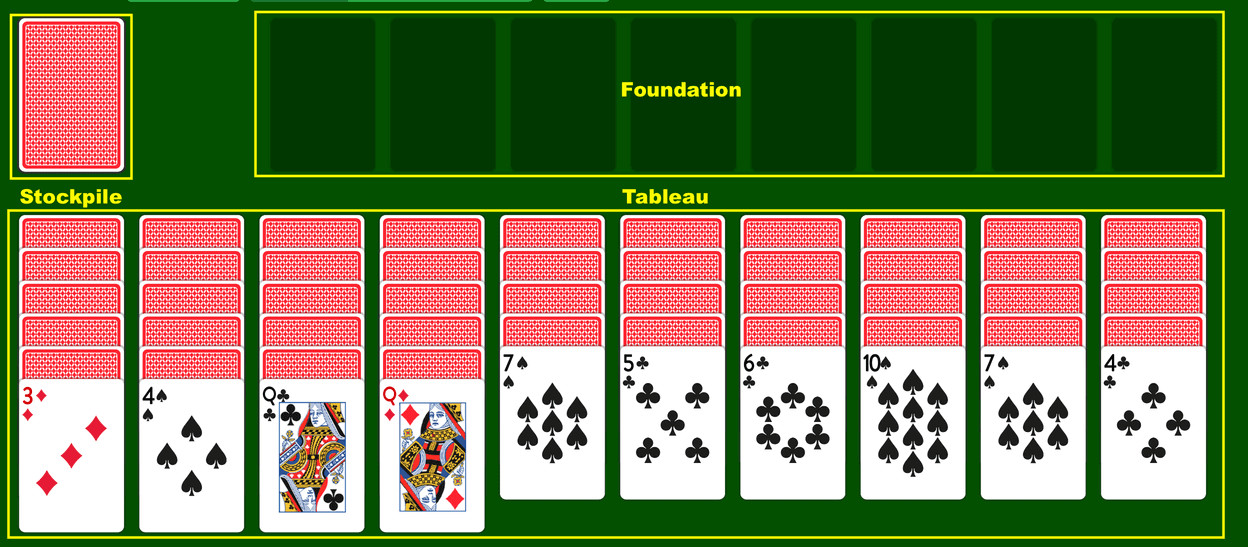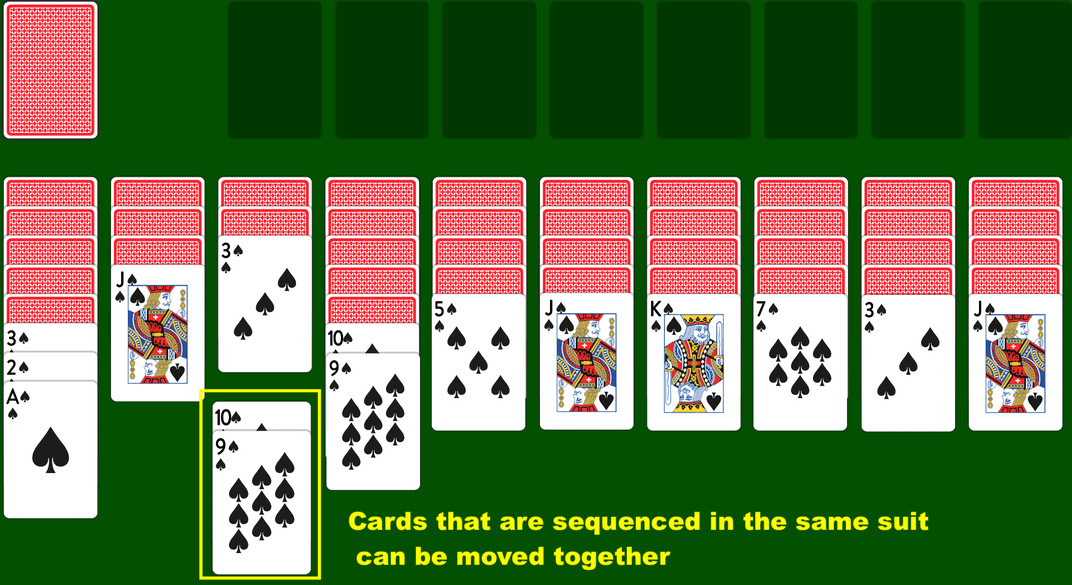Are you looking for a classic card game that’s both challenging and relaxing? Look no further than Spider Solitaire! This engaging game has captivated players for decades, and now you can enjoy it conveniently online. Whether you’re a seasoned solitaire pro or a curious beginner, Spider Solitaire Online offers endless hours of entertainment and mental stimulation, right at your fingertips. Click above to start playing unlimited free games now, no registration or download needed, and experience Spider Solitaire in full screen or on your mobile device!
Mastering Spider Solitaire: A Comprehensive Guide
Spider Solitaire is a captivating variation of the traditional solitaire card game. Your mission is to skillfully arrange 104 cards into eight foundation piles. This is achieved by meticulously sorting them within a tableau, building sequences down from King to Ace. Spider Solitaire online comes in three distinct difficulty levels, catering to every player’s skill level:
- 1 Suit Spider Solitaire: The perfect starting point for beginners, offering the simplest gameplay.
- 2 Suits Spider Solitaire: A step up in complexity, providing a moderate challenge for intermediate players.
- 4 Suits Spider Solitaire: The ultimate test for solitaire masters, demanding strategic thinking and careful planning.
The Objective: Building Foundations to Victory
The core objective of Spider Solitaire is to construct descending sequences of cards within the tableau columns, starting from King and progressing down to Ace. Whenever you successfully create a complete King-to-Ace sequence of the same suit, this sequence is automatically moved from the tableau to one of the eight foundation piles. Victory is achieved when all eight foundation piles are filled with suit-stacked cards, each running from King to Ace, and the tableau is completely cleared of cards.
Understanding the Setup and Play Area
Tableau: The heart of the game consists of ten columns. Initially, 54 cards are dealt into these columns. The first four columns each receive six cards, while the remaining six columns are dealt five cards each. Within this tableau, you’ll strategize and maneuver cards to create suited sequences from King to Ace.
Stockpile: After setting up the tableau, the remaining 50 cards form the stockpile. When you run out of moves within the tableau, you can draw ten cards from the stockpile. These cards are distributed one by one to each of the ten tableau columns, adding a new layer of complexity to the game.
Foundation: These are the eight empty piles where completed King-to-Ace sequences are automatically moved. Your ultimate goal is to fill all eight foundations to win the game of Spider Solitaire online.
 Spider Solitaire terms
Spider Solitaire terms
Navigating Your Moves in Spider Solitaire Online
- Building Sequences: You can move any face-up card onto another face-up card in the same column if it’s the next-highest rank, regardless of suit or color during gameplay in the tableau. For example, you can place a 9 of spades on top of a 10 of any suit.
 Nine on ten
Nine on ten
- Moving Card Groups: If you have a sequence of cards in descending order and of the same suit within a column, you can move this entire group as a single unit to another column. In the example below, the 10 and 9 of Spades can be moved together and placed on top of the Jack of Spades.
 Moving cards in a bunch
Moving cards in a bunch
-
Revealing Hidden Cards: As you move face-up cards, you might reveal face-down cards beneath them. When only face-down cards are left in a column, the topmost face-down card automatically flips over, revealing a new card that can be incorporated into your sequences.
-
Drawing from the Stockpile: When you reach a point where no more moves are apparent within the tableau, you can draw ten new cards from the stockpile. These cards are dealt face-up, one to each of the ten tableau columns, providing fresh opportunities for sequencing. You can draw from the stockpile a total of five times during a game.
-
Dealing with Blocked Cards: Drawing from the stockpile can sometimes disrupt existing sequences. In the example below, an Ace is now positioned on top of a 10. The 10 and Jack sequence below the Ace is temporarily blocked and cannot be moved until the Ace is moved. These three cards cannot be moved together as they are not in sequence.
 Moving cards in a bunch
Moving cards in a bunch
- Sequencing Below Blocked Cards: Even if a card is blocked, you can still continue to build sequences below it within the same column. In this example, despite the Queen being blocked by the Ace, you can still place a Jack on top of the Queen. To access the 9 and continue the sequence upwards, you’ll need to move the Queen and Jack sequence later.
 sequence after block
sequence after block
-
Utilizing Empty Columns: If you manage to clear an entire tableau column, it becomes an empty column. You can strategically move any single card or a group of sequenced cards to this empty column. However, you cannot draw cards from the stockpile if there are any empty columns.
-
Completing Foundations and Winning: As you skillfully maneuver cards and build descending King-to-Ace sequences of the same suit within a column, these completed sequences will automatically be moved to the foundation piles. Once all eight foundation piles are filled, you achieve victory in Spider Solitaire online! If you exhaust the stockpile and no further moves are possible, the game concludes, and you have not won.
Exploring 2 Suits and 4 Suits Spider Solitaire Online
Once you’ve mastered the fundamentals of 1 Suit Spider Solitaire, you can elevate your gameplay experience with 2 Suits Spider Solitaire or 4 Suits Spider Solitaire. These variations introduce added complexity, making the game more challenging and rewarding.
The basic setup and rules remain largely consistent across all difficulty levels. Two decks of cards are used in both 2 Suits and 4 Suits Spider Solitaire. In 2 Suits, only 54 cards from two suits are used. In 4 Suits, 26 cards from each of the four suits are utilized. The initial tableau layout is identical to 1 Suit Spider Solitaire. The key differences lie in the restrictions on moving card groups:
- Consistent Card Moving Rules: The fundamental rules of moving cards within the tableau remain the same across all difficulty levels.
- Suit-Specific Group Movement: In multi-suit versions, you can only move a group of cards together as a unit if they are both in sequential order and of the same suit.
- Inter-Suit Sequencing, Intra-Suit Movement Restriction: You can build sequences using cards of different suits or colors within the tableau columns. However, when it comes to moving card groups between columns, the sequence must be of a single suit to be moved together. If you place a 4 of Hearts on a 5 of Spades, the 5 of Spades is blocked from being moved as part of a sequence until the 4 of Hearts is relocated. These cards cannot be moved together as a group because they are not the same suit.
 sequence after block
sequence after block
- Empty Column Flexibility: Just like in 1 Suit Spider Solitaire, empty columns can be filled with any single card or a suited sequence in the multi-suit versions.
- Winning Conditions: The game is won when all foundation piles are filled. In 4 Suits Spider Solitaire online, this means completing two foundation piles for each of the four suits. In 2 Suits Spider Solitaire, you need to complete four foundation piles for each of the two suits in play.
The addition of more suits significantly increases the difficulty of Spider Solitaire. It demands greater precision and strategic thinking, as incorrect moves can easily trap crucial cards. As you progress to higher suit variations, the probability of winning naturally decreases, making each victory even more satisfying.
For a more in-depth exploration, consult our comprehensive guide on how to play Spider Solitaire.
Advanced Spider Solitaire Strategy: Tips to Enhance Your Gameplay
To truly excel at Spider Solitaire online, consider implementing these strategic tips:
- Prioritize Unveiling Face-Down Cards: Revealing hidden cards is paramount. It provides crucial information about available cards and potential sequencing opportunities. Before drawing from the stockpile, always strive to uncover as many face-down cards in the tableau as possible. This strategic approach maximizes your visibility and options.
- Strategic Use of Empty Columns: Creating empty columns is a powerful tactic. Empty columns offer temporary holding spaces for cards or sequences, facilitating complex maneuvers and freeing up blocked cards. Utilize them wisely to optimize your game.
- Maximize Empty Columns with High-Ranking Cards: When utilizing empty columns, prioritize moving higher-ranking cards, particularly Kings. Placing lower-ranking cards in empty columns limits their utility, as only a few cards can subsequently be placed upon them. Kings, on the other hand, offer greater flexibility, allowing you to build longer sequences and efficiently organize suited runs.
- Embrace the Undo Button: Don’t hesitate to use the undo button when you encounter moves that hinder your progress. Spider Solitaire online often presents intricate scenarios, and backtracking to explore alternative moves can be crucial for finding winning solutions.
Frequently Asked Questions about Spider Solitaire Online
What are the Winning Odds in 1 Suit Spider Solitaire?
1 Suit Spider Solitaire is generally considered to be the easiest difficulty level. Analyzing a substantial sample of 932,087 random games played on our platform, we observed that 487,429 games were won, resulting in a win rate of approximately 52.29%. This data illustrates that 1 Suit Spider Solitaire is significantly more winnable than its more complex counterparts – over three times easier than 2 Suits (16.6% win rate) and eight times easier than 4 Suits (6.2% win rate).
It’s important to acknowledge that not all Spider Solitaire hands are solvable, regardless of skill. However, employing effective strategies can substantially improve your chances of success.
Exploring Games Similar to Spider Solitaire
If you enjoy Spider Solitaire online, you might also appreciate other solitaire variations that offer similar strategic gameplay. Games like Scorpion Solitaire and Wasp Solitaire share elements of tableau building and sequence completion, providing engaging alternatives.
Delving into the History of Spider Solitaire
The name “Spider Solitaire” originates from the spider’s eight legs, mirroring the eight foundation piles that must be filled to achieve victory. While the modern iteration of the game emerged in 1949, early mentions of Spider Solitaire date back to Games Digest in 1937. This publication described a game remarkably similar to today’s Spider Solitaire, albeit with a slightly smaller tableau of 50 cards instead of 54. However, the article refers to it as a well-known game, suggesting that Spider Solitaire’s origins likely trace back to the early 1930s or even earlier.
Spider Solitaire’s widespread popularity surged with its inclusion in Microsoft Windows in 1998, introducing the game to a global audience.
Discovering Other Popular Solitaire Games
Beyond Spider Solitaire, a vast world of captivating solitaire games awaits exploration. Consider trying these popular variations:
- Klondike Solitaire (Classic Solitaire)
- FreeCell Solitaire
- Pyramid Solitaire
- TriPeaks Solitaire
For even more entertainment, explore our extensive collection of over 500+ free games and participate in our daily Solitaire challenges to test your skills. If you prefer app-based gaming, we’ve compiled a list of the best Spider Solitaire apps here.
Stay connected with fellow card game enthusiasts and receive updates by joining our Facebook community.
